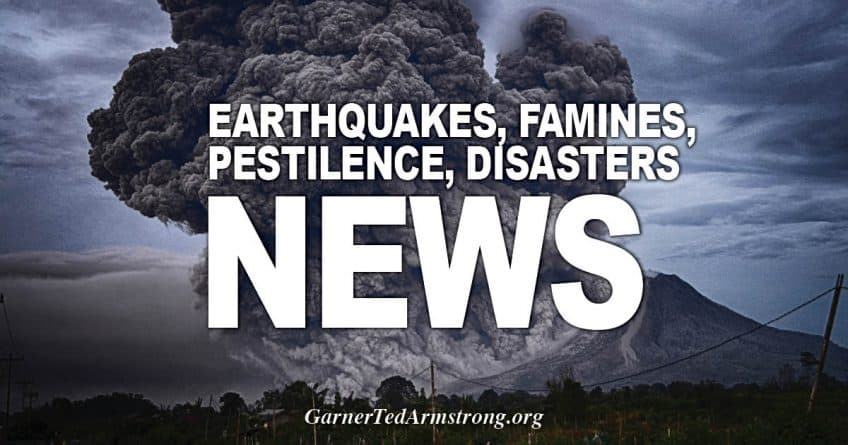The Colorado River is a critical resource for the western U.S. But a megadrought, one significantly exacerbated by climate change, is jeopardizing the river’s future and threatening to upend how its water is used and longstanding agreements between states. Miles O’Brien reports as part of our coverage on how climate change is creating a “Tipping Point” for the U.S. and around the world.
William Brangham:
The Colorado River is a critical source of water for the Western United States, but a mega-drought, one significantly exacerbated by climate change, is jeopardizing that river’s future, how that water gets used, and threatening longstanding agreements between states.
Miles O’Brien has our report.
It’s part of our coverage on how climate change is creating a tipping point for the U.S. and the world.
Miles O’Brien:
This is where the shortage meets the soil, Pinal County, Arizona, desert farmland between Phoenix and Tucson, lifelong home for farmer Nancy Caywood.
Nancy Caywood, Farmer:
My family has been farming in this area for 91 years. My grandfather bought this farm, 255 acres.
Miles O’Brien:
They grow alfalfa and cotton, both thirsty crops, which are not doing well right now.
Nancy Caywood:
This is the drought in action right here. I have never seen it this bad before.
Miles O’Brien:
Much of her water comes from canals that are filled by the Gila River, a tributary of the Colorado River. But in April of 2021, the water stopped flowing.
Nancy Caywood:
We don’t know when we will see water in here again.
Miles O’Brien:
Same goes for farmers in Pinal County who draw water directly from the Colorado River. When the U.S. government declared an official shortage for the river in August, farmers who depend on it were also drastically cut back.
Almost 1, 500 miles’ long, the Colorado winds its way through seven states and into Mexico. This river basin is filled with lush natural ecosystems. It transforms about 5.5 million acres of barren desert into fertile farmland; 40 million people are sustained by this water.
It’s one of the most heavily utilized rivers in the world, and it starts here, as a deep blanket of snow high in the Rocky Mountains of Wyoming, Utah, and Colorado.
Hydrologist Ben Livneh is an assistant professor at University of Colorado Boulder.
Ben Livneh, University of Colorado Boulder: Most of the of the water in the Colorado River starts as snowpack, and one of the reasons is that mountains act as these big catchments of precipitation.
Miles O’Brien:
But around the year 2000, a drought took hold and has not let go. This means less snow on those peaks in the Rockies year after year, and thus a steady reduction of water to feed the river.
The two largest reservoirs in the river basin, Lake Mead and Lake Powell, are now at all-time low levels. Climatologist Park Williams is an associate professor at UCLA. He uses tree rings to study the ancient climate.
Park Williams, UCLA:
The 2000s drought in the Colorado River Basin and across the Western United States has been as dry as any other 22-year period in the last millennium. The drought that we’re in today is not going to last forever, that it will break at some point when we have a string of really good luck years.
Miles O’Brien:
But the climate emergency has changed the odds. The global temperature is about two degrees Fahrenheit higher than it was before the Industrial Revolution.
Park Williams:
If climate change hadn’t happened, the West would still be in a drought, but the severity of the drought is undoubtedly worse because of climate change.
Miles O’Brien:
Here’s why. Warmer temperatures mean drier air. As the snowpack shrinks, it sheds water vapor into the atmosphere. A larger amount of snow melts into liquid water and rapidly evaporates in this warmer climate. Now the soil is dryer than usual.
Park Williams:
This causes the soils to act like a very dry sponge, and the next precipitation events that occurs on top of that dry sponge is going to work to refilling the soil sponge, as opposed to refilling our rivers and reservoirs.
Miles O’Brien:
This precious resource is allocated based on a 1922 agreement called the Colorado River Compact. Once the river basin states agreed on their fair shares, they each established a seniority system, first in time, first in right.
Ben Livneh:
There’s kind of a hierarchy of water rights. That means that people who gained access to the river first, they have what we would call a senior water right.
Miles O’Brien:
Colorado River water first came to Pinal County in the mid-1980s, upon completion of the Central Arizona Project, a network of canals that spans more than 300 miles across the desert.
It puts farmers here at the bottom of the seniority list, making them the first to go dry in the midst of this mega-drought.
Will Thelander, Farmer:
So, over the years, we have had to adapt to different whatever we can make money at, basically. So, on this farm, it’s really close to a bunch of dairies, and they need a bunch of feed.
Miles O’Brien:
Will Thelander is a third-generation farmer in Casa Grande. He and his family are part of an experiment in using their dwindling allocation of water on crops that demand less of it.
Will Thelander:
Here’s the guayule field. So you can see it’s in a nice bloom, and this crop hasn’t been watered for about two weeks.
Miles O’Brien:
They have planted a 40-acre tract of guayule, a plant that thrives in the desert and contains a milky latex that can be used to formulate rubber.
An acre can produce enough to make 50 tires. Bridgestone is working out the production kinks at this pilot plant, while Thelander does the same at this pilot plot.
Will Thelander:
With this crop, using half as much water as the corn, our water will last twice as long here. So that’s why the crop is so promising, and we really hope it takes off.
Miles O’Brien:
But for Nancy Caywood, the story is different. She can’t afford the cost of the new equipment required to harvest crops that need less water. She says she can hold onto the family farm for a year, but:
Nancy Caywood:
Eventually, the money runs out. You can’t pay the water and the taxes anymore. So it’s not your best interest to try to keep the land. Your best interest is to probably go ahead and sell. And it’s heart-wrenching to think that, but it’s true.
Miles O’Brien:
It would be the end of an era here, and maybe the beginning of a new one. Her neighbors recently sold their land, and it’s now a solar farm. Caywood has been approached by an energy company as well.
There is little to suggest this trend will reverse anytime soon. For years, humans overspent the Colorado River, and nature covered the overdrafts. But now the climate emergency has insured the bill has come due.
For the “PBS NewsHour,” I’m Miles O’Brien in Phoenix.
[Disclaimer]










